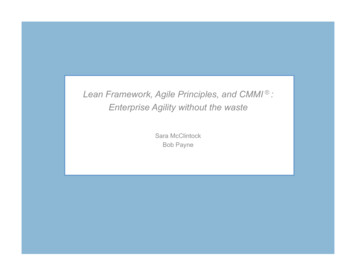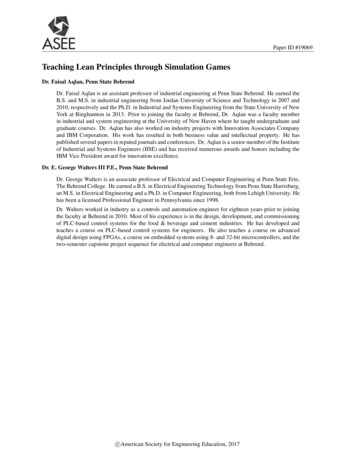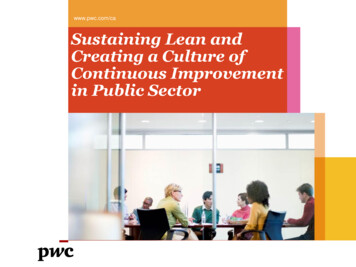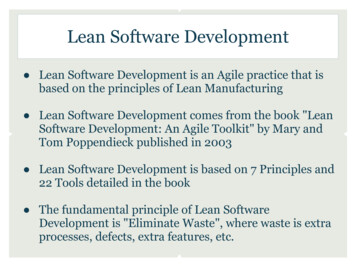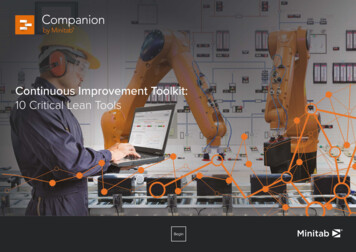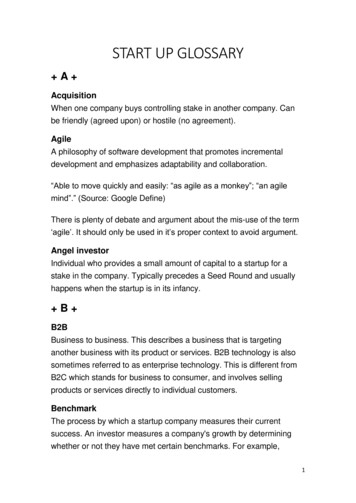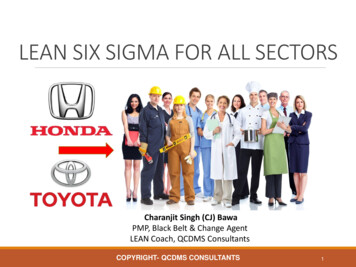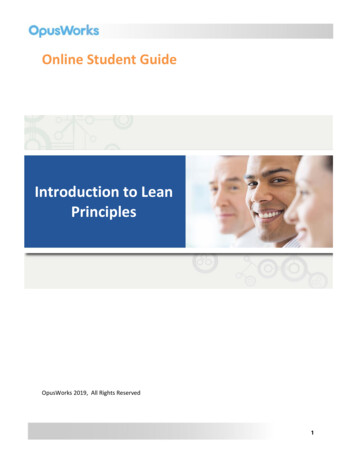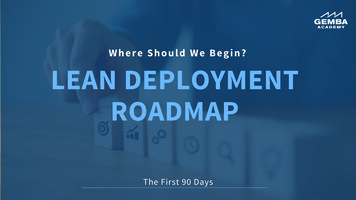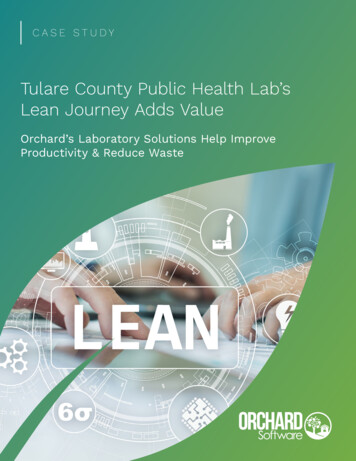
Transcription
STS11010Examensarbete 30 hpFebruari 2011Achieving Lean Software DevelopmentImplementation of Agile and Lean Practicesin a Manufacturing-Oriented OrganizationThomas Norrmalm
AbstractAchieving Lean Software Development:Implementation of Agile and Lean Practices in aManufacturing-Oriented OrganizationThomas NorrmalmTeknisk- naturvetenskaplig orietLägerhyddsvägen 1Hus 4, Plan 0Postadress:Box 536751 21 UppsalaTelefon:018 – 471 30 03Telefax:018 – 471 30 00Hemsida:http://www.teknat.uu.se/studentThe study reveals improvement areas in terms of lead time and quality in a traditionalsoftware development process of a large manufacturing-oriented organization, andidentifies four obstacles to the application of a Lean software development frameworkin order to achieve such improvements. The data from interviews are matched tofour predefined categories. These categories are evaluated using value streammapping and a framework of seven common improvement areas in softwaredevelopment. A large project and task tracking system indicate that lead time is a realproblem in the process. The most significant improvement area is wait time forchange approval meetings. A second prominent improvement area is the large amountof approval handshakes. At least a few of these handshakes are always approved, thusadding unnecessary lead time to the process.The four most imminent obstacles in adopting lean software development areidentified through estimating the efficiency of two in-house derivations of Scrum andKanban. The first obstacle is deep vertical but narrow horizontal expertise amongdevelopers. With some systems, there’s only one developer who knows how tomaintain the product. This makes it impossible to work as a team which is animperative principle of lean. A second obstacle is how the teams are arrangedorganizationally. They have a functional setup over three departments and threemanagers, which to some extent create a silo mentality, rendering cooperationdifficult. A third obstacle is how the teams are arranged geographically. Split over twolocations, manufacturing and headquarters, they have different customers, objectivesand a plain unfamiliarity with another that has reduced the will and opportunity tocommunicate and coordinate. A fourth obstacle is the inherent conflict between theprescriptive activities of ITIL, optimized for IT operational services, and theadaptability of agile methodologies, optimized for rapid change and empiricaldecisions. ITIL fulfills a sometimes uncalled for need to get all changes approvedthrough several layers of management.The study concludes that Lean software development is in conflict with manytraditional values of a manufacturing organization. Although lean may be prevalent inother parts of the organization, this does not necessarily include the IT function. ITstill seems to have hard time grasping the lean concepts of flow, waste and value.Handledare: Tommy HurtigÄmnesgranskare: Roland BolExaminator: Elisabet AndrésdóttirISSN: 1650-8319, STS11010
SammanfattningStudien visar på förbättringspotential inom ledtid och kvalitet i en traditionellmjukvaruutvecklingsprocess hos en stor tillverkningsorganisation. Studien identifierarockså fyra hinder för att applicera ett Lean software development-ramverk i syfte attåstadkomma sådana förbättringar. Data från intervjuer matchas mot fyra kategorier.Kategorierna är utvärderade med hjälp av värdeflödeskartor och ett ramverk med g.Ettomfattandeprojekthanteringsverktyg indikerar att långa ledtider är ett reellt problem i processen.Det tydligaste förbättringsområdet är väntetid inför möten där förändringar skagodkännas. Ett andra tydligt förbättringsområde är det stora antaletgodkännandeförfrågningar vid olika faser i processen. Åtminstone några avförfrågningarna godkänns alltid och förlänger således processens ledtid i onödan.De fyra mest omedelbara hindren för en anpassning till Lean software developmentpresenteras genom att bedöma effektiviteten i två egenutvecklade metoder baserade påScrum och Kanban. Första hindret är en hos utvecklarna djup vertikal men smalhorisontell expertis. I vissa system är det blott en utvecklare som har kunskapen atthantera systemet. Detta gör det omöjligt att arbeta i grupp, vilket är tvingande del avlean. Ett andra hinder är hur grupperna är arrangerade organisatoriskt. De har enfunktionell uppdelning över tre avdelningar och tre chefer, vilket till viss del skapar ettsilotänkande och gör samarbete svårare. Ett tredje hinder är hur grupperna fördelasgeografiskt. Eftersom de är spridda över två platser, huvudkontoret och fabriken, ochdärmed har olika kunder och målsättningar, och dessutom en allmänt låg förtrogenhetmed varandra, så är incitamentet för kommunikation och koordinering ännu lägre. Ettfjärde hinder är den inneboende konflikten mellan reglerade aktiviteter i ITIL, som äranpassade för IT-drift, och dynamiken i agil utveckling, som är optimerad förförändring och korta beslutsvägar. ITIL skapar ibland ett onödigt behov av attauktorisera förändringar genom flera nivåer av beslutsfattande.Studiens slutsats är att Lean software development är i konflikt med många traditionellavärderingar som man hittar i en tillverkningsorganisation. Trots att lean existerar i vissadelar av organisationen så behöver inte detta betyda att IT-organisationen tagit till sig avdess filosofi. Det tycks fortfarande vara svårt för IT att anamma lean-koncept som flow,waste och value.
AcknowledgementsThe paper you are holding in your hand was written during a 20 week period at the ITTWater & Wastewater headquarters in Stockholm. A lot of people helped me before,during, and after the study was conducted, too many to mention them all. I would,however, like to thank a few people who had a particularly important role in making thestudy possible.First I would like to thank Tommy Hurtig, my supervisor at Water & Wastewater, forgiving me the opportunity to do this study, and supplying me with every resource Icould possibly need. Secondly I would like to thank my reviewer, Roland Bol, forproviding guidance and valuable help with how to approach the scientific area of leanand agile. As a third and final thank you I would like to mention Britta Schreiber,teamleader at Water & Wastewater, who was an invaluable source in describing theways of work at the company.Thank you!Stockholm, January 2011Thomas Norrmalm
Table of Contents1. Introduction 11.1 Purpose 31.2 Aim 31.3 Methodology 31.3.1 Lean and Agile Principles 41.3.2 Timeline and Course of Action 51.4 Disposition 72. Theoretical Framework 82.1 Aspects of a Software Development Process (SDP) 82.1.1 Process Complexity 92.1.2 Prescriptive and Adaptive Methodologies 102.1.3 The Traditional Waterfall Approach 112.1.4 The Light-Weight Agile Initiative 122.2 Agile Software Development Methodologies 132.2.1 Scrum 142.2.2 Kanban 152.3 Applying Lean to Agile Software Development 162.3.1 Lean Philosophy 172.3.2 Lean Software Development 182.3.3 The Seven Wastes 193. Software Development at W&WW 243.1 Overview 243.2 IT function of W&WW 253.3 Teams Involved in the SDP 253.3.1 Emmaboda Developer Team 273.3.2 Sundbyberg Developer Team 273.3.3 Integration Team 283.3.4 Database Administrator Team 293.3.5 Web Team 303.3.6 Communication and Coordination 303.4 Frameworks 313.4.1 ITIL 313.4.2 PULS2 Project Management Template 323.5 The Software Development Process 333.5.1 Customer Initiating an RFC 343.5.2 Registration and Classification 363.5.3 Monitoring and Planning 363.5.4 Change Advisory Board Meeting (CAB1) 363.5.5 Building and Test 373.5.6 Change Advisory Board 2 (CAB2) and Implementation 384. Analysis 394.1 Value Stream Mapping and Process Efficiency 394.1.1 Bottlenecks 404.1.2 Waste 404.2 The Current State of Agile 424.3 The Conflict between ITIL, Regulation and Agile 44
4.4 Suggestions For An Agile SDP 454.4.1 Application portfolio and Single-point-of-failure 454.4.2 Team Setup and Communication 454.4.3 A Cross-Functional Team 464.5 Discussion: How to Keep Improving 465. Results 485.1 Further Studies 48References 49Appendix I IAppendix II IIAppendix III IIIAppendix IV IVAppendix V V
GlossaryPlease use this list for quick reference.COBOLCommon Business-Oriented Language – a programming language seen incorporate data centers and mainframesDepartmentAn organizational term for entities directly under functionsDot-net.NET Framework – a software framework developed by Microsoft for Windowsoperating systemsFunctionAn organizational term for the entities directly under W&WW value centerIDMSIntegrated Database Management System – a database management system usedto administrate the mainframeIT operationsThe group responsible for the day-to-day monitoring and management of ITServices and IT InfrastructureITTITT Corporation – Conglomerate acting in global markets including water andfluids management, defense and security, and motion and flow control. Is theparent company of W&WWMethodologyA framework used to structure, plan, and control the process of softwaredevelopmentPULS2Project management template used by all functions at W&WW except R&DRFCRequest For Change – A written, formal description of a wanted change in ainformation systemSDPSoftware Development Process – structure imposed on the development of asoftware product. Describes approaches to a variety of tasks or activities that takeplace during the processSOAService-Oriented Architecture – a set of design principles used during the phasesof systems development and integrationTeamA team comprises a group of people belonging to a departmentUATUser-Acceptance Test – Process to obtain confirmation that a system meetsmutually agreed-upon requirementsW&WWWater & Wastewater – global provider of water handling and treatment solutionsfor municipal and industrial customers in more than 140 countries
1. IntroductionThink about it. A cell phone, computer, laptop – perhaps even a tablet – you have one.Are they at work, at home, by the TV, by the kitchen table or just everywhere? ITappliances are becoming an inseparable part of our daily lives. Still, for most of us,these appliances are just a “thing”, a black box that enables a certain action in a certaincontext. To buy a train ticket, for example. We surf the web, enter a few text strings andvoilà, a ticket is generated on the screen. At least most of the time. When this black boxfails us, however – may it be due to loss of connection, a bug in the software, orincompatibilities with the browser – we become distressed. But because we know thatlife without IT systems is no longer possible, we calm down just as quick and restart thesystem. Suddenly it works again. The software works again.This paper, in essence, is about how software can be made better. How do you makesoftware better? You must improve the process of making it, of course. Over the years,many “best ways” of creating software have emerged and disappeared. The latest one toemerge is agile. Agile, in its general definition, is often described asthe ability to change the body's position efficiently, requiring the integration ofisolated movement skills using a combination of balance, coordination, speed,reflexes, strength, endurance and staminaDoes it sound promising as a way of creating software? Hard to tell, depends on whatyou compare it to. The traditional approach to software development is based onmanufacturing principles. Manufacturing is defined as the act ofcreating or producing in a mechanical way, or the transformation of raw materialsinto finished productsHow can these approaches be even remotely related, and why in software development?How do they perform, in comparison? That is the topic of this paper. One must,however, put these methodologies in context of history to fully understand theirimplications.In 2008, the value of the global software industry was US 303.8 billion (Software:Global Industry Guide 2009). In 2013 the global software market is predicted to valueUS 457 billion, an increase of 50.5 percent. Although still growing, the softwareindustry is already considered the third-largest U.S. manufacturing business, afterautomobiles and electronics. With such remarkable growth, and over 40 years1 ofsoftware development in the making, you would expect a high degree of maturity in theproduction of software. This, however, is not the case. Software development projectsare still closely tied to properties such as poor quality, past deadline, over budget,buggy – or simply failure. Some say a third of the projects are failures, some even twothirds (Standish Chaos report 2003); in either case, the numbers are extraordinary.Imagine car manufacturing where only two thirds of the cars coming out of the factoryare functional. How can this difference in success rate be explained?1I consider the NATO sponsored conferences on software engineering in 1968 and 1969 to be the officialstart software development as it is known today.1
A part of the explanation is found in the old manufacturing principles of Fordism andTaylorism (i.e. the scientific method) that still dominate the development of industrialproducts and software. Generic software development processes such as the SoftwareEngineering Institute’s Capability Maturity Model and ISO 9000/9001 were conceivedto standardize the software development process, exactly like they had standardized themanufacturing of traditional products. Discipline and professionalism were described assilver bullets. Unfortunately, the continuation of the software crisis into the 1980srevealed that the quest for perfect software still was not over (Brooks 1986).The next approach to show promise was the Japanese principles of quality. With theaddition of lean principles, the traditional manufacturing model of development was tobe perfected, or at least that was the plan (Mah 2008). Reality, however, proveddifferent. Rather than improving software development, today’s projects are stillperforming as dire as they did in the 80s, with late deliveries and unfulfilled customerrequirements still as common as ever (Mah 2008). Most researchers argue that there isno single approach that could resolve all complexities in software development (Brooks1995).In recent years, lean and agile principles have gained popularity in addressing problemssuch as long development life cycles and rapidly changing customer requirements.Poppendieck et al (2003, 2005 and 2009) has taken lean and agile thinking to propose anew software development methodology, lean software development, which combinecore principles of delivering customer value, minimize waste and maximize flow.Properly implemented, lean software development promises increased productivity andreduced lead time (Bjørnvig et al 2010). The methodology proposes improvementparticularly for medium to large companies with a history of lean in manufacturing,where the philosophies already imbue some parts of the organization (Poppendieck et al2009). Although quantitative research on agile methodologies versus traditionalmethodologies is rather scarce, Mah (2008) and Ambler (2007) indicate that someimpressive results may be achieved. Mah (2008) compares the performance of 23 agileprojects against an industry average of 7,500 completed software projects in theQuantitative Software Management Associates database. He concludes that about 80percent of the agile projects were completed quicker than similarly sized traditionalprojects. In terms of quality, traditional manufacturing type projects reported a higherdefect rate when using large teams, sometimes as much as four times higher than theagile average. Mature agile project teams showed a defect rate that remains proportionalto the project’s increase in size (Mah 2008).ITT Water & Wastewater (W&WW) has a long tradition in manufacturing andindustrial applications. With 5800 employees, it is the world's largest supplier of pumpsand systems for the transportation, treatment and control of water (W&WW official site2010). The company is a part of the ITT Corporation conglomerate, a globallydiversified manufacturing company with revenues of 11.7 billion in 2008. ITTparticipates in several other global markets, including defense and security, and motionand flow control (ITT official site 2010). W&WW consider software developmentimportant in keeping the in-house software competitive. The IT department isresponsible for developing tools related to calculation, configuration, selection anddesign of complicated watering solutions that ships to resellers on a global scale. Thesoftware solutions aim to greatly simplify and automate work for sales, manufacturingand engineers on-site. (Teamleader A, 2010)2
The IT department, with a staff of approximately 150 employees, is based inSundbyberg and Emmaboda in Sweden; the majority of software development alsotakes place in these two locations (Teamleader A, 2010). Today’s development processis a traditional sequential waterfall process, based on processes from the manufacturingside of the company. Development progress is made by sequentially entering the phasesof concept, initiation, analysis, design, construction, testing and maintenance. Leadtimes, however, are becoming increasingly long, and there is a prominent problem ofprojects being cancelled half-way through (Teamleader B, 2010). In recent years themanufacturing part of the company has begun working towards lean principles ofmanagement. This, however, has not been implemented in the software developmentprocess. This paper aims to shed light on the downsides and benefits of implementinglean software development practices in such a context.1.1 PurposeThe purpose of this study is to contribute to the understanding of how lean and agileprinciples can be combined to reduce lead time in the software development division ofa large manufacturing-oriented organization.1.2 AimThe aim of this study is to answer the following research questions: How is the software development at ITT W&WW organized?To what extent can a Lean software development framework improve thesoftware development process in terms of minimizing waste?What are the most imminent obstacles in implementing such a framework?The analysis is focused on the earlier parts of the software development process, mainlythe change management process. The release and maintenance process will not becovered in any detail. Focus is on developer teams rather than architectural teams. Withthat said, knowledge had to be gained in how interaction between all stakeholders in theprocess work, thus requiring a general idea of how the other teams work as well.1.3 MethodologyTo successfully produce software is a complex process. A complex process has a largeset of variables affecting its performance. What this thesis aim to do is to deliver astarting point to improve on those variables; a qualitative evaluation how theorganization performs and what agile and lean principles can bring to reduce lead-timeand improve quality over time.The way of measuring performance in this paper is based on the SoftwareBenchmarking Organization’s (2010) definition. The Software BenchmarkingOrganization offers a set of best practice key performance indicators (KPIs) to measureperformance in software development projects. They define software developmentperformance asthe efficiency of the development process in terms of value-adding core activities,support activities, prevention activities ( reviews, inspections) and appraisal/reworkactivities (testing, defect removal) (Benchmarking Organization, 2010)3
W&WW has no implementation of KPIs, and thus no quantitative measure to estimatethe performance of the development organization (Teamleader B 2010). Therefore fewnumbers are available that indicate the efficiency of the current SDP. The aim of myfindings is consequently to suggest a relative improvement over a previously unknownstate.1.3.1 Lean and Agile PrinciplesCentral to the thesis is lean and agile principles (see 2.3 for a more comprehensivediscussion on frameworks, concepts and definitions). By using the waste-value conceptand related tools an organization can continuously measure and improve its processes.The main analysis tool of this thesis is the value map stream, which maps the valueadding activities of the SDP, and the seven wastes of lean software development, a set ofwaste activities that are commonly seen in development (Poppendieck et al 2003). Thelean value map is used to give an overall view of the process, and the seven wastesserves as a guide to focus the effort of finding waste. It has been shown, as is alsodiscussed in the introduction, that agile approaches seldom decrease performance over atraditional manufacturing-inspired approach. Therefore, by using light-weight agilemethodologies as a good practice comparison, arguments can be presented how wastein the process can be reduced.A number of sources contributed to my interpretation of agile and lean, and theirunification in the approach called lean software development. Mary and TomPoppendieck (2003, 2007 and 2010) are the founders of the lean software movement.Their work merge lean manufacturing, lean IT and agile, and they present their insightsfrom both a managerial and developing viewpoint. Mixing them with the books by Beck(2004), Bjørnvig et al (2010), Cohen (2010) and numerous Internet resources gave mean in-depth understanding of how agile projects can add value in practically anyorganization. It also provided, perhaps more importantly, scenarios where agileperforms less well.The Internet is, as always when studying an IT related subject, a vivid resource of up-todate reports, literature and perceptions. Lean software development is no exception tothis rule. The research area is still very active with many blogs, reports, white papersand formal and informal communities that discuss topics on a day-to-day basis. Theworks of Mikael Lundgren (2010) and Henrik Kniberg and Mattias Skarin (2010) areparticularly valuable in my understanding of agile methodologies Kanban and Scrum inboth practice and theory.Many of the front figures in the community do agile coaching for a living and as such,they may have a tendency to favor the techniques they teach. These subjective opinionswere neutralized to the extent possible by cross-checking numbers, and always keepinga critical standpoint in regard to unverifiable data. It is, however, very hard to findanyone within software development who advocates the traditional waterfall approach.The general standpoint is therefore that a properly implemented agile approach is moreefficient than the traditional approach under most circumstances.The author’s objectivity towards W&WW can be questioned; I spent two monthsworking in one of the projects taking place in the IT department during 2010. I doargue, however, that the company has a welcoming and open approach and that myprevious experiences as an employee not directly interfere with the purpose of thisthesis. On the contrary, I think the background I had when starting this thesis was very4
valuable. The teams were somewhat familiar with me which, in terms of trust, gave mea head start.1.3.2 Timeline and Course of ActionThe data of this study is collected through four methods: a literature review (seediscussion above), interviews and observation. The majority of data-collection tookplace at the W&WW headquarters in Sundbyberg, Stockholm, over a time-span ofapproximately 20 weeks. The thesis had a pre-established project plan, most of whichwas kept in phase with (see table 1).Table 1. Course of action, from initial stages to analysis. (Source: Author)#PurposeActivitySubject1Literature study. Overview ofthe accumulated knowledge inlean and agileReading of books, reports,white papers and blogsMyself2Overview of the ITTconglomerate, down to theteams on different branches ofthe IT organizationStructure thoughts andMyselfexperiences from myprevious work at W&WW.Write down realizationsand create categorization3Gain in-depth understanding ofwhat W&WW softwaredevelopment aims to achieve.Basic understanding of thedifferent teams and theirmethodologiesOverview interview, semistructured interviews.Adjust categorizationsafter new realizations andsort data accordinglyTeamleaders,developers4Gain understanding of theSundbyberg developer teamand their way of workSemi-structuredinterviews, sort data incategoriesSundbybergdevelopers andteamleaders5Gain understanding of theSemi-structuredEmmaboda developer team and interviews, sort data intheir way of workcategoriesEmmabodadevelopers andteamleaders6Establish process efficiencyand find bottlenecksRetrieve information fromprocesses category. Mapvalue stream and analysisContinuousmeetings with oneteamleader7Analyze the organization inrelation to the seven wastesframeworkRetrieve information fromteam and self-reflectioncategories. Analysis ofresultsMyself andfeedback fromteamleaderAlthough literature reviews (table 1, step 1) were the initial step, most data collected inthis paper emerged as an iterative cycle between theoretical conceptions and empiricaldata. This means that during empirical data collection, I continuously reviewed my dataagainst the literature and revisited sources when in need of clarification.5
During step 2, the subjects to interview were selected. The aim of my selection was tocapture the views and opinions of managers as well as developers. Once selection wasdone, initial contact was taken through mail, direct communication or over the phone.All of the interviews were semi-structured; I sketched a few topics that were relevant towhat I wanted to know about a specific activity in the software development process,and the topics were given beforehand to the interviewee. Topics were structured inaccordance to the role of the subject (see Appendix V for detailed topics): Teamleaders were mainly asked about their team’s purpose and workflow, andhow they cooperated and coordinated with other teamsDevelopers were asked how they experience their current work situation, andhow they worked practically with tools and computersManagers were asked how they staffed projects, and how priorities betweendifferent tasks were doneThe collected data were categorized by type: self-reflection, team, development processand overall process. These categories were created to simplify the interview process,and align data with the lean software development framework. The self-reflectioncategory included data on how the interviewees reflect on their own process and lean.Team category included data on teams’ purpose, setup and external collaboration. Thedevelopment process category and overall process category included data on thespecific build and test process and the entire process, respectively. When referred to inthe paper, all interviewees are anonymous and gender neutralized. Source references aremade with the organizational role of the interviewee and a letter.After the interviews were done, the next phase took place (see table 1, step 6). At thisstage my understanding of workflows and processes was sufficient. The next step wasto map the actual flow using the value map. This was done in cooperation with one ofthe teamle
1.3.1 Lean and Agile Principles _ 4 1.3.2 Timeline and Course of Action _ 5 . IDMS Integrated Database Management System - a database management system used . appliances are becoming an inseparable part of our daily lives. Still, for most of us,
